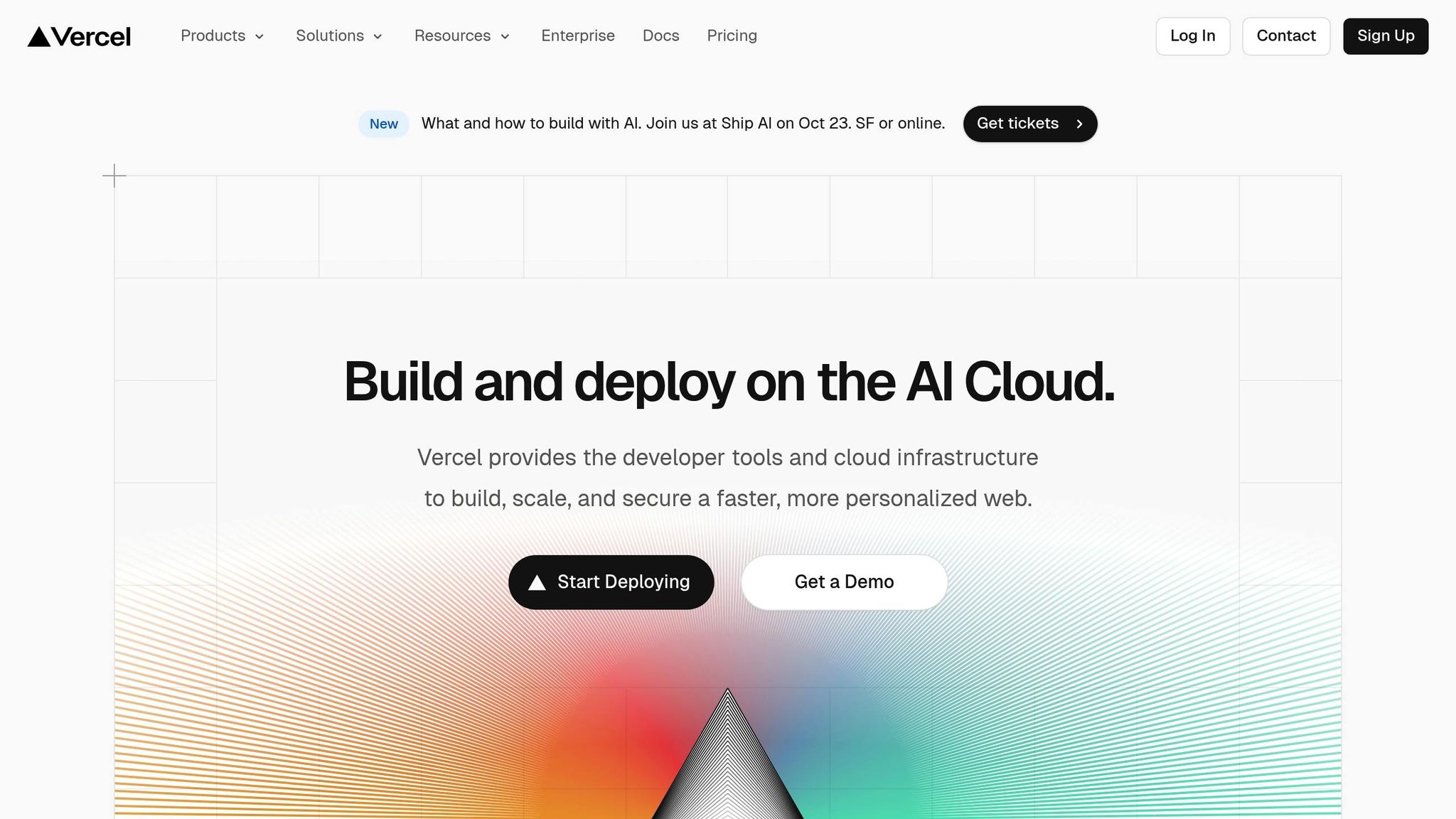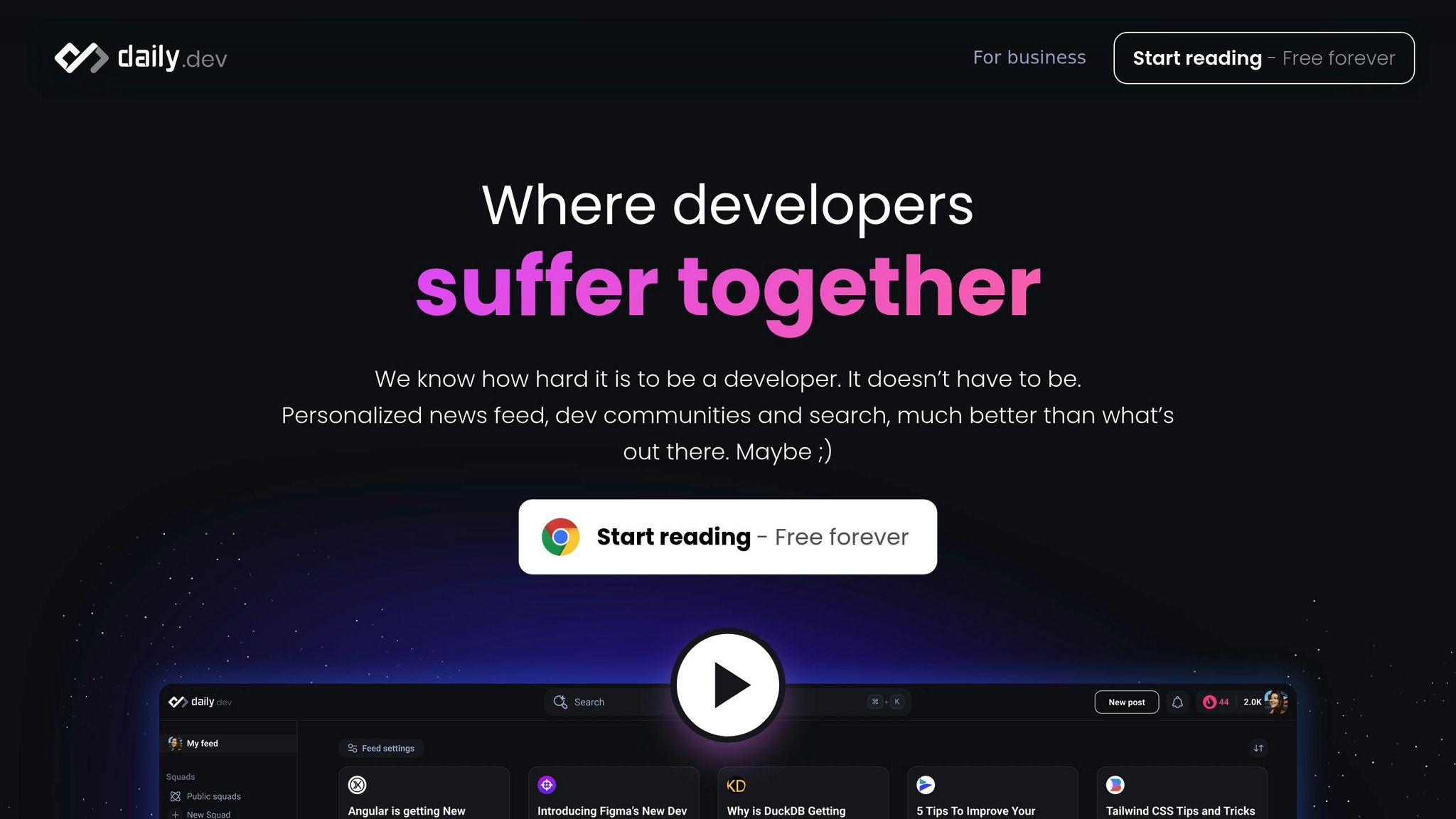


Learn how to effectively engage developers through authentic communication, trust-building, and targeted marketing strategies across various platforms.
Reaching developers is all about trust, technical depth, and meeting them on platforms they already use. Developers avoid hard-sell tactics and prefer content that solves problems, offers clear instructions, and respects their time. Building long-term relationships requires understanding their preferences and engaging authentically.
Here’s how to connect with developers effectively:
- Be where they are: Platforms like Stack Overflow, GitHub Discussions, Reddit, and Discord are key for technical conversations.
- Share useful content: Tutorials, detailed documentation, and case studies resonate most.
- Leverage targeted ads: Platforms like daily.dev Ads allow precise targeting based on skills, seniority, or interests.
- Focus on trust: Transparent communication, open-source contributions, and technical credibility are essential.
- Use multi-channel strategies: Combine forums, blogs, social media, and events for maximum impact.
Developers value accuracy, efficiency, and transparency. By addressing their challenges directly and using the right mix of channels, you can build meaningful connections and stand out in a crowded market.
The Ultimate Guide to Developer Marketing | Lee Robinson (Vercel)

Understanding the Developer Audience
Developers in the U.S. are a distinct group with specific expectations and behaviors. They’re often skeptical of traditional marketing and have a sharp ability to filter out irrelevant information. To connect with them, it’s crucial to understand how they think and what they value.
Developer Demographics and Preferences
For developers, solving problems takes priority over everything else. When evaluating tools, services, or content, their main question is, "Does this solve a problem I actually have?" This mindset drives how they assess information and make decisions.
Accuracy is critical. Developers won’t waste time on content that feels shallow or lacks technical depth. They value detailed documentation, code samples, and step-by-step guides far more than flashy videos or generic feature lists. If they’re exploring a new tool, they want to see exactly how it works in practice.
Peer recommendations are another key factor. Insights or endorsements from respected figures on platforms like GitHub or Stack Overflow can heavily influence their opinions. That’s why content grounded in real-world experiences often outperforms traditional marketing.
Time is also a limited resource for developers. Juggling multiple projects and staying updated on new technologies means they prefer content that gets straight to the point. Long-winded sales pitches won’t hold their attention - clarity and efficiency will.
These habits and preferences underline the importance of trust in building meaningful relationships with developers.
Why Trust Matters in Developer Marketing
Trust isn’t just a nice-to-have in developer marketing - it’s the foundation for success. Developers don’t adopt tools or services lightly; they do their homework first.
To earn their trust, technical credibility is a must. Developers need to believe that the people behind a product truly understand their challenges. Marketing teams can’t rely on buzzwords or fluff - they need to demonstrate real technical knowledge and provide content that addresses real-world problems and implementation details.
Consistency is another cornerstone of trust. Developers notice when companies overpromise or change technical details. Every interaction, whether through content, tools, or communication, can either build or damage that trust.
Transparency also goes a long way. Sharing product roadmaps, acknowledging known issues, and providing timelines for fixes shows respect for developers’ time and intelligence. Open communication builds credibility.
Community involvement matters just as much. Developers gravitate toward companies that actively contribute to open-source projects, engage in industry discussions, and support the broader developer ecosystem. Brands that give back to the community earn more goodwill than those that only aim to profit from it.
Ultimately, solving real problems is the most effective way to build trust. When a company consistently delivers helpful blog posts, practical tools, or meaningful community contributions, developers begin to view it as a resource they can rely on - not just another vendor trying to sell them something.
Top Developer Marketing Channels in 2025
Developer platforms now span both familiar and newer channels. Success in this space requires knowing where developers spend their time and how they prefer to consume information. By focusing on platforms where developers are already active, brands can build trust and amplify their campaign impact. Below are some of the key channels for connecting with developers in 2025.
Developer Communities and Forums
Stack Overflow continues to be a go-to platform for developers seeking solutions. Its Q&A format allows brands to establish credibility by providing well-thought-out, detailed answers to technical questions. Developers value precision, and helpful contributions can significantly boost a brand’s reputation.
GitHub Discussions has evolved into more than just a code repository. It’s now a lively hub where developers share their experiences with tools and libraries in practical contexts. For instance, when Vercel introduced its Edge Functions, GitHub Discussions became a space for early adopters to share feedback and real-world examples, including actual code implementations.
Reddit remains a hotspot for broader programming discussions. Subreddits like r/programming and r/webdev offer authentic spaces where developers can engage in meaningful conversations without the intrusion of heavy-handed promotions.
Discord servers have become indispensable for real-time interaction. Communities like The Programmer's Hangout and Reactiflux provide instant feedback and foster direct discussions. These platforms are particularly useful for companies offering developer tools that benefit from live troubleshooting and active community support. Beyond forums, well-crafted technical content on blogs and publications also plays a critical role in engaging developers.
Tech Blogs and Publications
Dev.to has cemented its position as a favorite for developer-focused content. Educational articles that address practical problems resonate deeply with its audience, making it a valuable space for companies to share in-depth tutorials.
Hashnode offers a more personalized blogging experience, allowing developers to publish on custom domains while leveraging an existing audience. Its clean design and SEO-friendly features make it an attractive option for sharing technical insights.
Medium continues to thrive as a platform for technical publications. Outlets like Better Programming and The Startup prioritize actionable advice over surface-level content, helping companies build recognition and trust within the developer community.
Company engineering blogs are another powerful tool for connecting with developers. Blogs from organizations like Netflix, Uber, and Airbnb stand out by sharing detailed case studies and addressing real-world challenges. Developers value this level of transparency and technical depth, which helps build long-term credibility.
Social Media and Professional Networks
Social media and professional networks offer dynamic ways to engage with developers in real-time.
Twitter (now X) remains a key platform for quick, digestible content like coding tips, code snippets, and industry discussions. Influential figures like Kyle Simpson and Dan Abramov demonstrate how sharing expertise and engaging with followers can create strong, supportive communities.
LinkedIn has evolved into more than just a professional networking site. It’s now a hub for educational content targeting senior developers and technical decision-makers. Companies that share in-depth insights and industry trends often find LinkedIn to be an effective channel for reaching their audience.
YouTube continues to grow as a major resource for developer education. Channels that focus on technical content - offering detailed walkthroughs and tutorials - attract large, engaged audiences who appreciate visual explanations of complex topics.
TikTok is emerging as a surprising new space for reaching younger developers. Creators are breaking down coding concepts into short, accessible videos, offering quick tips and behind-the-scenes looks at the development process.
Twitch has carved out its own niche with live coding streams. Many developers now tune in to watch real-time coding sessions, creating opportunities for live tool demos and interactive discussions. Companies have successfully tapped into this trend by sponsoring popular streamers or hosting their own live coding events.
Spotlight on daily.dev Ads: A Platform for Developer Engagement

daily.dev Ads is a tailored advertising platform designed exclusively for the developer community. With a reach of over 1 million developers worldwide, it offers a trusted space where technical professionals consume curated content daily.
Unlike broader advertising platforms, daily.dev Ads operates within a focused ecosystem where developers are already engaged and actively seeking technical knowledge. This allows brands to connect with their target audience in a natural, non-disruptive way.
Native Ad Placements for Developers
daily.dev Ads integrates seamlessly into the developer's daily content journey, offering ad placements that feel natural and unobtrusive.
The platform features in-feed ads that appear organically within the content stream. This ensures developers encounter ads as part of their regular browsing experience, without disrupting the flow of technical articles and resources.
Another option is post page ads, which are strategically placed on pages where developers are deeply immersed in specific technical content. These placements strike a balance between high visibility and maintaining the user experience developers value.
Additionally, daily.dev is rolling out personalized digest ads, which deliver targeted content based on individual reading habits and technical interests. This ensures that promotional material feels relevant and aligned with the user's needs, enhancing engagement without feeling intrusive.
Advanced Targeting Capabilities
daily.dev Ads offers precise targeting options designed to address the diverse needs of the developer community. Advertisers can tailor campaigns to reach specific segments, ensuring their message resonates with the right audience.
- Seniority levels: Whether it's junior developers exploring new tools or senior engineers making purchasing decisions, campaigns can be adjusted to match the audience's expertise and needs.
- Programming languages: Target developers by their preferred tech stack, such as JavaScript, Python, or Go, to promote products or tools that align with their expertise.
- Geographic location: Focus on regional campaigns, such as US-based tech hubs like San Francisco, Seattle, or Austin, or schedule campaigns to align with peak activity in specific time zones.
- Open-source activity: Reach developers involved in community projects, ideal for companies aiming to connect with active contributors or developer advocates.
| Targeting Option | Best Use Case | Example Application |
|---|---|---|
| Seniority Level | Tailoring messaging complexity | Senior developers for enterprise tools, juniors for learning resources |
| Programming Languages | Technology-specific products | Promoting React libraries to JavaScript developers |
| Geographic Location | Regional campaigns and events | US-based developer conferences or local meetups |
| Open-Source Activity | Community-focused initiatives | Targeting active contributors for developer advocacy programs |
The platform also features dynamic creative optimization, which adjusts ad content in real time based on performance and audience data. This ensures campaigns remain relevant and effective, evolving to meet the preferences of different developer segments.
Creative Best Practices for daily.dev Ads
To capture the attention of developers, effective ads need to prioritize technical relevance over traditional marketing tactics. Developers are drawn to content that directly addresses their challenges and offers practical solutions.
Credibility is key. Ads that include real code snippets, technical specs, or implementation details tend to resonate more with developers than generic promotional content. Transparency and technical depth are far more effective than flashy marketing language.
Visuals should support, not overshadow, the message. Clean, professional designs that highlight features or benefits work better than overly elaborate graphics, which can feel out of place in a technical setting.
daily.dev Ads also provides tools and guidance to help advertisers optimize their campaigns. With real-time performance tracking, marketers can fine-tune their creative elements based on data, ensuring their campaigns remain effective. This approach aligns perfectly with the analytical mindset developers bring to their work, making the advertising experience more impactful.
sbb-itb-e54ba74
Building an Effective Multi-Channel Developer Marketing Strategy
To connect with developers effectively, you need a strategy that works across multiple platforms. Developers interact with various channels throughout their day, so your approach should adapt a consistent core message to fit each platform's unique format.
Let’s dive into the key components of building a strategy that truly resonates with developers.
Content That Resonates with Developers
Developers gravitate toward content that is practical and solves real-world problems. The most impactful content generally falls into three categories: educational tutorials, detailed documentation, and case studies that highlight real-world applications.
Educational content should prioritize teaching over selling. Tutorials that guide developers through building something useful tend to perform well. Include actual code snippets, clear step-by-step instructions, and explanations of why certain methods are better suited for specific tasks. This hands-on approach ensures developers walk away with actionable knowledge.
API documentation is another critical tool. Developers rely on well-structured, up-to-date documentation that provides clear examples, common use cases, and troubleshooting tips. Think of it as both a resource and a subtle marketing tool - when done right, it not only informs but also builds trust.
Case studies resonate deeply when they showcase how others have tackled and solved technical challenges. Developers appreciate seeing the nitty-gritty details: the problem, the solution process, and the measurable results. Highlighting trade-offs and decision-making processes makes these stories even more valuable.
But great content alone isn’t enough. Engaging directly with developer communities is just as important.
Engaging Developers Through Communities
To build credibility within developer communities, focus on providing value first - not on promoting your product. The most successful efforts involve team members who are genuinely part of the community and not just marketers trying to sell something.
Forum participation is a great starting point. Encourage your team to answer questions, share insights, and join discussions. Having technical experts on hand to provide thoughtful, accurate responses to complex issues can establish trust over time. The goal here isn’t instant results but long-term credibility.
Open-source contributions are another powerful way to connect with developers. Whether it’s contributing to existing projects, maintaining helpful libraries, or open-sourcing internal tools, these efforts demonstrate technical expertise and create lasting value for the community.
Developer advocacy programs take engagement to the next level. These programs often involve hiring experienced developers to represent your company authentically in technical spaces. Their focus should be on education and community engagement, not direct sales. When done well, these advocates can significantly amplify your presence and reputation.
By combining these efforts, you can create meaningful connections with developers while building long-term trust.
Measuring and Optimizing Campaign Performance
When it comes to measuring success, developer marketing requires a different approach than traditional B2B marketing. While lead generation is still important, engagement and community growth metrics are often better indicators of long-term success.
Engagement metrics should measure whether your content is genuinely useful to developers - not just how many clicks it gets. High levels of engagement often translate into stronger conversion rates over time.
Community growth indicators give you a sense of how your brand is perceived within developer circles. Metrics like GitHub stars, forks, forum reputation scores, and even invitations to speak at conferences can reveal how well you’re connecting with your audience.
Attribution tracking can be tricky with developer audiences due to their longer sales cycles and multiple touchpoints. A developer might discover your product through a blog post, explore it further on GitHub, discuss it in forums, and only recommend it to decision-makers months later. Multi-touch attribution models are better suited to capturing this complex journey than last-click attribution.
A/B testing is essential for fine-tuning your approach. Focus on elements that matter to developers, such as the clarity of code examples, the depth of your content, or the structure of your documentation. Testing different formats and engagement tactics can help you align your strategy with developer preferences.
Lastly, regularly review both quantitative metrics and qualitative feedback. Pay attention to forum sentiment, trends in support tickets, and insights from sales teams about lead quality. The goal isn’t just to measure performance but to understand whether your campaigns are fostering positive relationships with the developer community.
Cross-channel optimization is key to maximizing your impact. For instance, developers who engage with your educational content across multiple platforms may be more likely to try your product than those who only encounter your ads. Understanding these patterns allows you to allocate resources more effectively and refine your strategy over time.
Comparison of Developer Marketing Channels
Selecting the right marketing channels for a developer audience means understanding the strengths and limitations of each platform. Success depends on factors like audience reach, engagement, and how well the channel aligns with your campaign goals.
Channel Strengths and Weaknesses
When evaluating developer-focused marketing channels, four main factors come into play: reach potential, engagement depth, targeting precision, and campaign suitability. Here's a breakdown of some key options:
| Channel | Reach | Engagement Depth | Targeting Precision | Best For | Limitations |
|---|---|---|---|---|---|
| Developer Communities (Stack Overflow, Reddit, Discord) | High (65.7% use Stack Overflow) | Very High | Medium | Problem-solving content, technical discussions, community building | Requires genuine participation; overly promotional content is often rejected |
| Tech Blogs & Publications (Personal blogs, HackerNoon, Smashing Magazine) | Medium to High | High | Low to Medium | Thought leadership, detailed tutorials, SEO-driven content | Time-intensive; tracking conversions can be difficult |
| Social Media Platforms (LinkedIn, Twitter/X, GitHub) | High | Medium | High | Brand awareness, quick updates, professional networking | Short content lifespan; 42.9% of developers feel neutral about ads |
| daily.dev Ads | High (1M+ developers) | High | High | Native advertising, precision targeting, tool promotion | Still a growing platform with a niche audience |
| Developer Events (Conferences, meetups, webinars) | Medium | High | High | Product demos, relationship building, thought leadership | Higher cost per contact; limited frequency |
Let’s dive deeper into these channels and their unique benefits.
Developer communities, such as Stack Overflow, Reddit, and Discord, are excellent for building trust and fostering engagement. Stack Overflow's wide reach makes it ideal for establishing technical credibility, but these platforms demand authentic, value-driven contributions. Promotional content that feels forced or insincere is likely to be ignored - or worse, rejected.
Tech blogs and publications are perfect for showcasing expertise through detailed tutorials and thought leadership. They also work well for boosting SEO. However, the content creation process can be time-consuming, and tracking direct results from these efforts isn’t always straightforward.
Social media platforms like LinkedIn, Twitter/X, and GitHub offer significant reach. LinkedIn stands out for professional networking, with 51.4% of developers using it, while Twitter/X is a hub for technical discussions (45.7% usage). Despite their reach, 42.9% of developers express neutral feelings toward social media ads, so subtle, value-driven messaging is key to success.
daily.dev Ads brings a unique advantage with its ability to target developers based on programming languages, seniority, and technical interests. With over 1 million developers in its ecosystem, the platform seamlessly integrates native ads into developers' content feeds. This approach reduces ad resistance and ensures your message reaches a highly relevant audience.
Developer events, including conferences, meetups, and webinars, provide opportunities for high-touch engagement. These settings are ideal for showcasing complex tools or products that benefit from in-depth explanations. However, they tend to have higher costs per contact and are less frequent compared to other channels.
A successful developer marketing strategy often requires a multi-channel approach. For instance, communities build credibility, blogs offer in-depth content, social media drives awareness, daily.dev Ads deliver precise targeting, and events create meaningful connections. This combination ensures you maximize your campaign's impact.
Ultimately, aligning your campaign goals with the strengths of each channel is essential. Developers value technical precision and trust, so tailoring your strategy to fit these expectations will make all the difference.
Conclusion: Maximizing Impact in Developer Marketing
Reaching developers requires a unique approach. Unlike other audiences, developers prioritize authenticity, technical accuracy, and practical solutions over flashy sales pitches. This mindset demands a strategy that connects with them on their terms and across multiple platforms.
A multi-channel strategy is key to success. Each channel plays a specific role: developer forums like Stack Overflow help establish credibility, tech blogs position your brand as a leader in the field, social media platforms amplify awareness and foster connections, and niche ad platforms provide targeted outreach. The best campaigns weave these channels together, delivering a consistent message at every touchpoint.
At the heart of developer marketing lies trust and credibility. Developers are quick to dismiss content that feels fake or overly promotional. Instead, focus on delivering real value - whether through educational resources, actionable solutions, or honest communication about your product's strengths and limitations.
Platforms like daily.dev Ads are transforming how brands connect with this audience. With access to over 1 million developers, it allows for precise targeting based on programming languages, experience levels, and technical interests. Its native ad placements blend seamlessly into the developer's daily routine, minimizing resistance while boosting engagement.
To ensure your efforts pay off, track and refine your strategy. Monitor metrics that developers care about: technical engagement, community activity, and actual product usage - not just vanity numbers. Use these insights to tweak your messaging, adjust your channel mix, and continuously improve your campaigns.
Ultimately, success in developer marketing comes down to reaching the right people with the right message. Developers are one of the most influential groups in the tech world, and by respecting their preferences, offering meaningful value, and utilizing the right mix of channels, you can create strong, lasting relationships. It’s not about casting the widest net - it’s about connecting with the right audience in a way that resonates.
FAQs
What are the best ways for companies to build trust with developers when marketing their products?
To earn trust from developers, companies need to prioritize honesty, genuine communication, and active involvement. Share early iterations of your product, provide meaningful technical resources, and take developer feedback seriously. These steps demonstrate that you're invested in understanding their challenges and delivering something that truly helps.
Steer clear of over-the-top promises or shallow marketing strategies. Focus on keeping your messaging clear, accurate, and practical. Regularly engaging with developer communities and addressing their questions or concerns can build lasting credibility and strengthen trust over time.
How can I effectively engage developers on platforms like Stack Overflow and GitHub?
To connect with developers on platforms like Stack Overflow and GitHub, focus on being genuinely helpful and contributing real value to the community. Offer clear, well-explained solutions to specific issues, include practical code examples, and engage in discussions with thoughtful, constructive comments.
On GitHub, get involved by starting or improving open-source projects, submitting detailed pull requests, and addressing issues with actionable suggestions. On Stack Overflow, earn trust by providing accurate answers, referencing reliable sources, and keeping a professional tone. Consistency and sincerity are essential for building a strong reputation and forming meaningful relationships with developers.
Why is it important to use multiple marketing channels to connect with developers?
Reaching developers effectively means meeting them on the platforms they already frequent - whether that's coding forums, open-source communities, or tech-focused social networks. Using multiple marketing channels ensures your message gets seen in places developers trust and engage with regularly, broadening your reach to a wider audience.
This multi-channel approach also allows for a more cohesive and tailored experience. By connecting with developers across various platforms, you can adjust your messaging to align with their preferences and habits. Over time, this not only strengthens your connection with them but also builds long-term loyalty.






